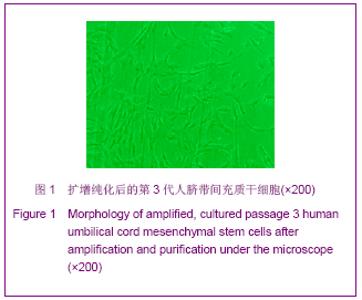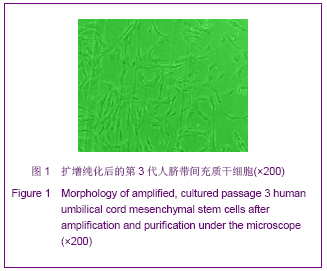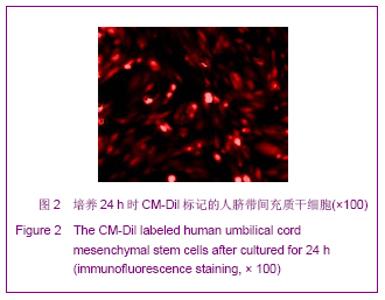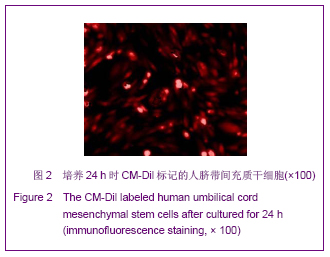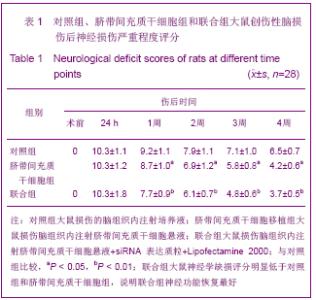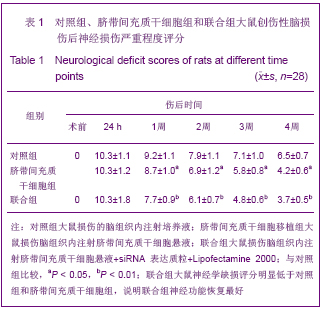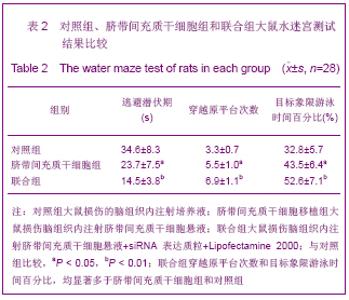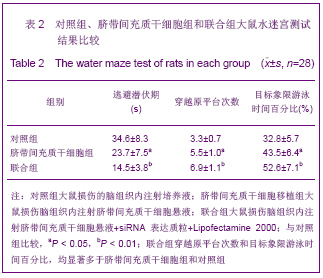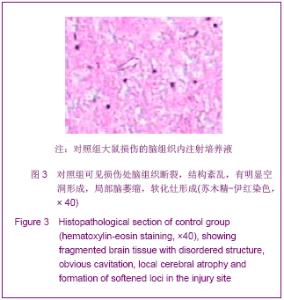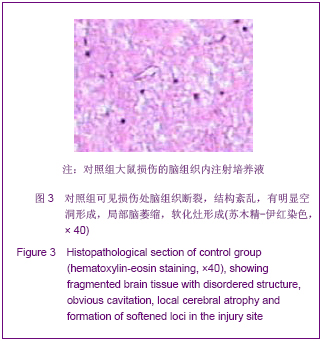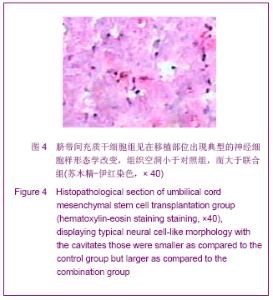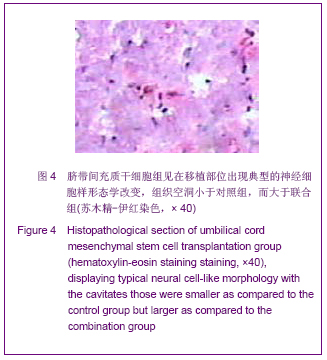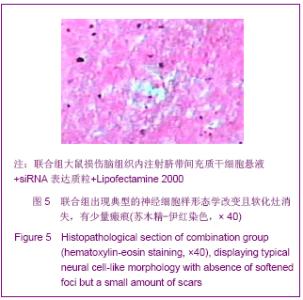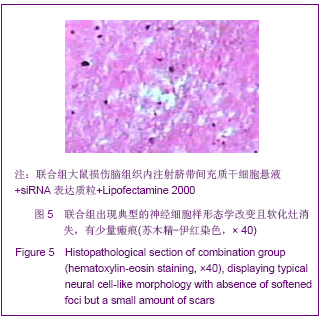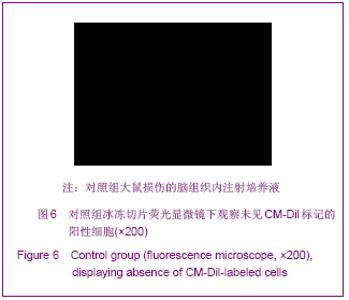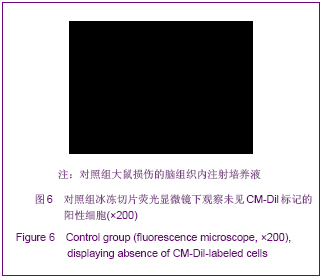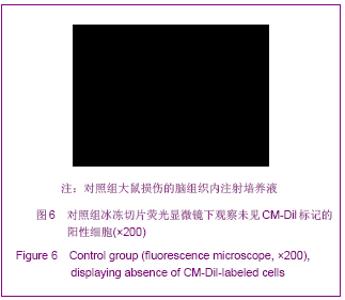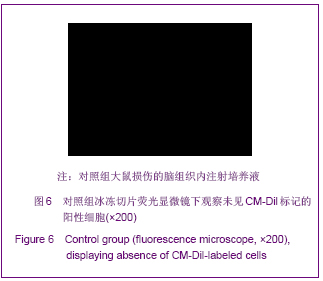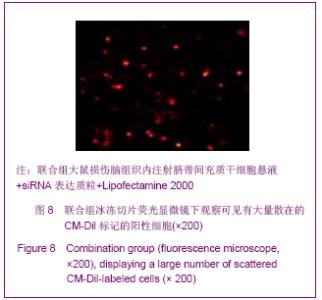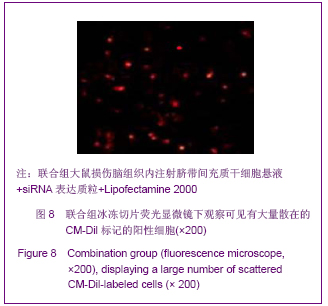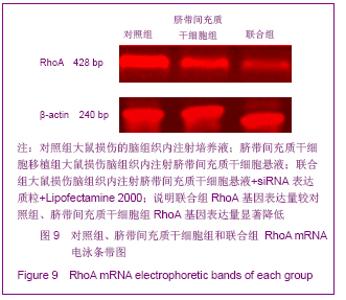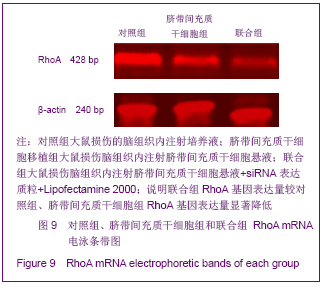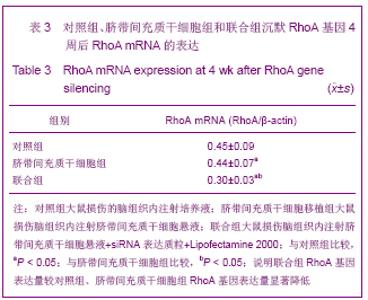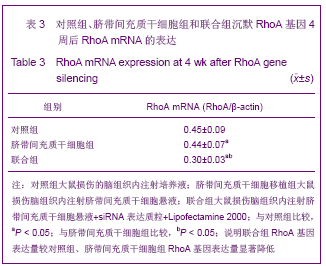Chinese Journal of Tissue Engineering Research ›› 2013, Vol. 17 ›› Issue (1): 23-30.doi: 10.3969/j.issn.2095-4344.2013.01.004
Previous Articles Next Articles
Treatment of traumatic brain injury in rats by RhoA gene silencing combinedwith umbilical cord mesenchymal stem cell transplantation
Feng Shi-jun, Han Jian-guo
- Department of Neurosurgery, First Affiliated Hospital of Baotou Medical College, Baotou 014010, Inner Mongolia Autonomous Region, China
-
Received:2012-10-05Revised:2012-12-05Online:2013-01-01Published:2013-01-01 -
About author:Feng Shi-jun★, Master, Associate chief physician, Department of Neurosurgery, First Affiliated Hospital of Baotou Medical College, Baotou 014010, Inner Mongolia Autonomous Region, China qxy20110824@163.com
CLC Number:
Cite this article
Feng Shi-jun, Han Jian-guo. Treatment of traumatic brain injury in rats by RhoA gene silencing combinedwith umbilical cord mesenchymal stem cell transplantation[J]. Chinese Journal of Tissue Engineering Research, 2013, 17(1): 23-30.
share this article
| [1] Arabi YM, Haddad S, Tamim HM,et al. Mortality reduction after implementing a clinical practice guidelines–based management protocol for severe traumatic brain injury. J Crit Care.2010;25(2):190-195.[2] Lee HC, Chuang HC, Cho DY, et al. Applying Cerebral Hypothermia and Brain Oxygen Monitoring in Treating Severe Traumatic Brain Injury. World Neurosurg. 2010;74(6): 654-660.[3] Engelmann CM, Siert L. Cognitive disturbances following severe traumatic brain injury. Ugeskr Laege. 2007; 169(3): 217-219.[4] Liliang PC, Liang CL, Weng HC, et al. Proteins in Serum Predict Outcome After Severe Traumatic Brain Injury. J Surg Res. 2010;160(2): 302-3078.[5] Sekhon MS, Dhingra VK, Sekhon IS,et al.The safety of synthetic colloid in critically ill patients with severe traumatic brain injuries. J Crit Care.2011;26(4):357-362.[6] Yoo BY, Shin YH, Yoon HH,et al.Application of mesenchymal stem cells derived from bone marrow and umbilical cord in human hair multiplication.J Dermatol Sci. 2010, 60(2): 74-83.[7] Xu Y,Meng H,Li C,et alUmbilical cord-derived mesenchymal stem cells isolated by a novel explantation technique can differentiate into functional endothelial cells and promote revascularization. Stem Cells.2010;19(10):1511-1522. [8] Matsuse D,Kitada M,Kohama M,et al. Human umbilical cord-derived mesenchymal stromal cells differentiate into functional Schwann cells that sustain peripheral nerve regeneration.J Neuropathol Exp Neurol.2010;69(9):973-985.[9] Yuan GF, Li HX. Zhongguo Xiandai Yixue Zazhi. 2011;21(13): 1435-1438.苑国富,李红星.大鼠颅脑损伤后亚低温治疗对RhoA 及Nogo- A 表达的影响[J].中国现代医学杂志,2011, 21(13):1435-1438.[10] Wang QY, Liu WG, Wang ZY. Zhongguo Guke Linchuang yu Jichu Yanjiu Zazhi.2010;2(4):292-296.王求永,刘文革,王振宇.FTY720对大鼠急性脊髓损伤后RhoA 表达的影响[J].中国骨科临床与基础研究杂志,2010,2(4):292-296.[11] Ahmed Z, Dent RG, Suggate EL, et al. Disinhibition of neurotrophin-induced dorsal root ganglion cell neurite outgrowth on CNS myelin by siRNA-mediated knockdown of NgR, p75NTR and Rho-A. Molecular and Cellular Neuroscience.2005;28(3):509-523.[12] Chen L,Hui GZ,Zhang S,et al.Zhonghua Chuangshang Zazhi. 2009;25(6):498-502.陈镭,惠国桢,张赛,等.人脐血间充质干细胞移植促进大鼠颅脑损伤后神经功能的恢复[J].中华创伤杂志,2009,25(6):498- 502.[13] Horisawa T, Ishibashi T, Nishikawa H, et al. The effects of selective antagonists of serotonin 5-HT7 and 5-HT1A receptors on MK-801-induced impairment of learning and memory in the passive avoidance and Morris water maze tests in rats: Mechanistic implications for the beneficial effects of the novel atypical antipsychotic lurasidone . Behavioural Brain Res. 2011;220 (1): 83-90.[14] Mutlu O, Ulak G, Celikyurt IK et al, Effects of olanzapine, sertindole and clozapine on learning and memory in the Morris water maze test in naive and MK-801-treated mice.Pharmaco Biochem Behav. 2011;98(3): 398-404.[15] Li L, Ding J, Marshall C, et al.Pretraining affects Morris water maze performance with different patterns between control and ovariectomized plus d-galactose-injected mice. Behavioural Brain Research.2011;217(1): 244-247.[16] Hang RH, Xu YJ, Xie HF.Evaluating on recognition impairment after traumatic brain injury with WCST.Fa Yi Xue Za Zhi. 2011;27(5):346-349. [17] Han SR, Yee GT, Choi CY,et al.Cortical laminar necrosis in an infant with severe traumatic brain injury.J Korean Neurosurg Soc. 2011;50(5):472-474. [18] Shultz SR, Macfabe DF, Foley KA, et al.Sub-concussive brain injury in the Long-Evans rat induces acute neuroinflammation in the absence of behavioral impairments.Behav Brain Res. 2011;229(1):145-152. [19] Settervall CH, Sousa RM, Silva SC.In-hospital mortality and the Glasgow Coma Scale in the first 72 hours after traumatic brain injury.Rev Lat Am Enfermagem. 2011;19(6):1337-1343. [20] Yamashita S, Hasuo H, Tokutomi T,et al. Edaravone attenuates impairment of synaptic plasticity in granule cell layer of the dentate gyrus following traumatic brain injury. Kurume Med J. 2011;58(2):47-58.[21] Han SR, Yee GT, Choi CY, et al Cortical laminar necrosis in an infant with severe traumatic brain injury.J Korean Neurosurg Soc. 2011;50(5):472-474. [22] Hang RH, Xu YJ, Xie HF,et al. Evaluating on recognition impairment after traumatic brain injury with WCST.Fa Yi Xue Za Zhi. 2011;7(5):346-349. [23] He JT, Mang J, Mei CL,et al. Neuroprotective effects of exogenous activin a on oxygen-glucose deprivation in PC12 cells.Molecules. 2011;30(17):315-327.[24] Li GX,Wang CM,Gong LP,et al.Zhongguo Linchuang Shenjing Waike Zazhi. 2009,14(5):288-290.黎国雄,王传湄, 龚利平,等.神经干细胞立体定向脑内移植治疗大鼠重型颅脑损伤[J].中国临床神经外科杂志,2009,14(5): 288-290.[25] Zhao EY, Wang LD, Wen QQ, et al. Fasudil hydrochloridedifferentiates bone marrow mesenchymal stem cells into neurons via Notch signaling. Neural Regen Res. 2010;5(11):814-819.[26] Dergham P,Ellezam B,Essagian C,et al.Rho signaling pathwaytargeted to promote spinal cord repair. J Neurosci. 2002;22(15):6570-6577. [27] Govek EE,Newey SE,Aelstl V. The role of the Rho GTPases in neuronal development. Genes Dev.2005;19(10): 1-49.[28] Neuhof S,Moers J,Ricks M. Proliferation, diferentiation, and cytokine secretion of human umbilical cord blood-derivedmononuclear ceils in vitro.Exp Hematol.2007; 35(7):1119-1131.[29] Pang KM, Sung MA, Alrash-dan MS, et al. Trans-plantation of mesenchymal stem cells from human umbilical cord versus human umbilical cord blood for peripheral nerve regenera-tion. Neural Regen Res. 2010;5(11):838-845.[30] Ha Y,Choi JU,Yoon DH,et a1.Neural phenotype expression of cultured human cord blood cells in vitro. Neurureport. 2001; 12(16):3523-3530.[31] Buzahska L,Jurga M,Domafiska-Janik K.Neumnal differentiation of human umbilical cord blood neural stem- like cell line.Neurodegener Dis.2006;3(1-2):19-26.[32] Wang D,Zhang JJ,Mang JJ.Zhongguo Zuzhi Gongcheng Yanjiu yu Linchuang Kangfu. 2010,14(14): 2539-2544.王东,张建军,马景鑑.神经干细胞NgR基因沉默立体定向移植治疗大鼠脑损伤[J].中国组织工程研究与临床康复,2010, 14(14): 2539-2544.[33] Neuhof S,Moers J,Ricks M.Proliferation,diferentiation,and cytokine secretion of human umbilical cord blood-derived mononuclear ceils in vitro.Exp Hematol.2007;35(7): 1119-1131.[34] Zhou GQ,Jin Y,Zhang P.Zhongguo Zuzhi Gongcheng Yanjiu yu Linchuang Kangfu. 2010;14(45):8416-8420.周国庆,金怡,张鹏.沉默RhoA基因对骨髓间充质干细胞静脉移植治疗脑梗死大鼠的作用[J].中国组织工程研究与临床康复, 2010,14(45):8416-8420. |
| [1] | Jiang Tao, Ma Lei, Li Zhiqiang, Shou Xi, Duan Mingjun, Wu Shuo, Ma Chuang, Wei Qin. Platelet-derived growth factor BB induces bone marrow mesenchymal stem cells to differentiate into vascular endothelial cells [J]. Chinese Journal of Tissue Engineering Research, 2021, 25(25): 3937-3942. |
| [2] | Mo Jianling, He Shaoru, Feng Bowen, Jian Minqiao, Zhang Xiaohui, Liu Caisheng, Liang Yijing, Liu Yumei, Chen Liang, Zhou Haiyu, Liu Yanhui. Forming prevascularized cell sheets and the expression of angiogenesis-related factors [J]. Chinese Journal of Tissue Engineering Research, 2021, 25(22): 3479-3486. |
| [3] | Chen Lei, Zheng Rui, Jie Yongsheng, Qi Hui, Sun Lei, Shu Xiong. In vitro evaluation of adipose-derived stromal vascular fraction combined with osteochondral integrated scaffold [J]. Chinese Journal of Tissue Engineering Research, 2021, 25(22): 3487-3492. |
| [4] | Wei Qin, Zhang Xue, Ma Lei, Li Zhiqiang, Shou Xi, Duan Mingjun, Wu Shuo, Jia Qiyu, Ma Chuang. Platelet-derived growth factor-BB induces the differentiation of rat bone marrow mesenchymal stem cells into osteoblasts [J]. Chinese Journal of Tissue Engineering Research, 2021, 25(19): 2953-2957. |
| [5] | Chen Xiao, Guo Zhi, Chen Lina, Liu Xuanyong, Zhang Yihuizhi, Li Xumian, Wang Yueqiao, Wei Liya, Xie Jing, Lin Li. Factors affecting the mobilization and collection of autologous peripheral blood hematopoietic stem cells [J]. Chinese Journal of Tissue Engineering Research, 2021, 25(19): 2958-2962. |
| [6] | Guo Zhibin, Wu Chunfang, Liu Zihong, Zhang Yuying, Chi Bojing, Wang Bao, Ma Chao, Zhang Guobin, Tian Faming. Simvastatin stimulates osteogenic differentiation of bone marrow mesenchymal stem cells [J]. Chinese Journal of Tissue Engineering Research, 2021, 25(19): 2963-2968. |
| [7] | Li Congcong, Yao Nan, Huang Dane, Song Min, Peng Sha, Li Anan, Lu Chao, Liu Wengang. Identification and chondrogenic differentiation of human infrapatellar fat pad derived stem cells [J]. Chinese Journal of Tissue Engineering Research, 2021, 25(19): 2976-2981. |
| [8] | Gao Yuanhui, Xiang Yang, Cao Hui, Wang Shunlan, Zheng Linlin, He Haowei, Zhang Yingai, Zhang Shufang, Huang Denggao. Comparison of biological characteristics of adipose derived mesenchymal stem cells in Wuzhishan inbreed miniature pigs aged two different months [J]. Chinese Journal of Tissue Engineering Research, 2021, 25(19): 2988-2993. |
| [9] | Cao Yang, Zhang Junping, Peng Li, Ding Yi, Li Guanghui. Isolation and culture of rabbit aortic endothelial cells and biological characteristics [J]. Chinese Journal of Tissue Engineering Research, 2021, 25(19): 3000-3003. |
| [10] | Dai Min, Wang Shuai, Zhang Nini, Huang Guilin, Yu Limei, Hu Xiaohua, Yi Jie, Yao Li, Zhang Ligang. Biological characteristics of hypoxic preconditioned human amniotic mesenchymal stem cells [J]. Chinese Journal of Tissue Engineering Research, 2021, 25(19): 3004-3008. |
| [11] | Qin Yanchun, Rong Zhen, Jiang Ruiyuan, Fu Bin, Hong Xiaohua, Mo Chunmei. Chinese medicine compound preparation inhibits proliferation of CD133+ liver cancer stem cells and the expression of stemness transcription factors [J]. Chinese Journal of Tissue Engineering Research, 2021, 25(19): 3016-3023. |
| [12] | Dai Yaling, Chen Lewen, He Xiaojun, Lin Huawei, Jia Weiwei, Chen Lidian, Tao Jing, Liu Weilin. Construction of miR-146b overexpression lentiviral vector and the effect on the proliferation of hippocampal neural stem cells [J]. Chinese Journal of Tissue Engineering Research, 2021, 25(19): 3024-3030. |
| [13] | Chen Jie, Liao Chengcheng, Chen Zhiwei, Wang Yan. Bladder cancer stem cell markers and related signaling pathways: antibody targeted therapy [J]. Chinese Journal of Tissue Engineering Research, 2021, 25(19): 3090-3096. |
| [14] | Zhang Wei, Cui Shuaishuai, Zhou Zhichao, Hu Xiaohua, Yang Xiaohong. MicroRNA regulates histone deacetylase in the treatment of bone-related diseases [J]. Chinese Journal of Tissue Engineering Research, 2021, 25(17): 2767-2774. |
| [15] | Chen Liang, Meng Shu, Cheng Guoping, Ding Yi . Effects of fish scale collagen membrane on adhesion, proliferation and osteogenic differentiation of rat bone marrow mesenchymal stem cells [J]. Chinese Journal of Tissue Engineering Research, 2021, 25(16): 2494-2499. |
| Viewed | ||||||
|
Full text |
|
|||||
|
Abstract |
|
|||||
